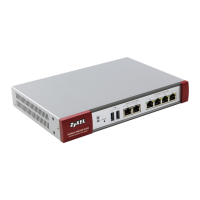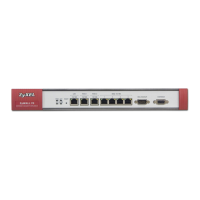Chapter 9 Interfaces
USG20(W)-VPN Series User’s Guide
148
Ethernet interfaces are similar to other types of interfaces in many ways. They have an IP address,
subnet mask, and gateway used to make routing decisions. They restrict the amount of bandwidth
and packet size. They can provide DHCP services, and they can verify the gateway is available.
Use Ethernet interfaces to control which physical ports exchange routing information with other
routers and how much information is exchanged through each one. The more routing information is
exchanged, the more efficient the routers should be. However, the routers also generate more
network traffic, and some routing protocols require a significant amount of configuration and
management. The USG supports two routing protocols, RIP and OSPF. See Chapter 10 on page 239
for background information about these routing protocols.
Figure 119 Configuration > Network > Interface > Ethernet
Each field is described in the following table.
Table 63 Configuration > Network > Interface > Ethernet
LABEL DESCRIPTION
Configuration / IPv6
Configuration
Use the Configuration section for IPv4 network settings. Use the IPv6
Configuration section for IPv6 network settings if you connect your USG to an IPv6
network. Both sections have similar fields as described below.
Edit Double-click an entry or select it and click Edit to open a screen where you can modify
the entry’s settings.
Remove To remove a virtual interface, select it and click Remove. The USG confirms you want
to remove it before doing so.
Activate To turn on an interface, select it and click Activate.
Inactivate To turn off an interface, select it and click Inactivate.
Create Virtual
Interface
To open the screen where you can create a virtual Ethernet interface, select an
Ethernet interface and click Create Virtual Interface.
Object References Select an entry and click Object Reference to open a screen that shows which
settings use the entry. See Section 9.3.2 on page 164 for an example.
# This field is a sequential value, and it is not associated with any interface.
Status This icon is lit when the entry is active and dimmed when the entry is inactive.
Name This field displays the name of the interface.

